stop start FORD EDGE 2010 1.G User Guide
[x] Cancel search | Manufacturer: FORD, Model Year: 2010, Model line: EDGE, Model: FORD EDGE 2010 1.GPages: 328, PDF Size: 2.29 MB
Page 244 of 328
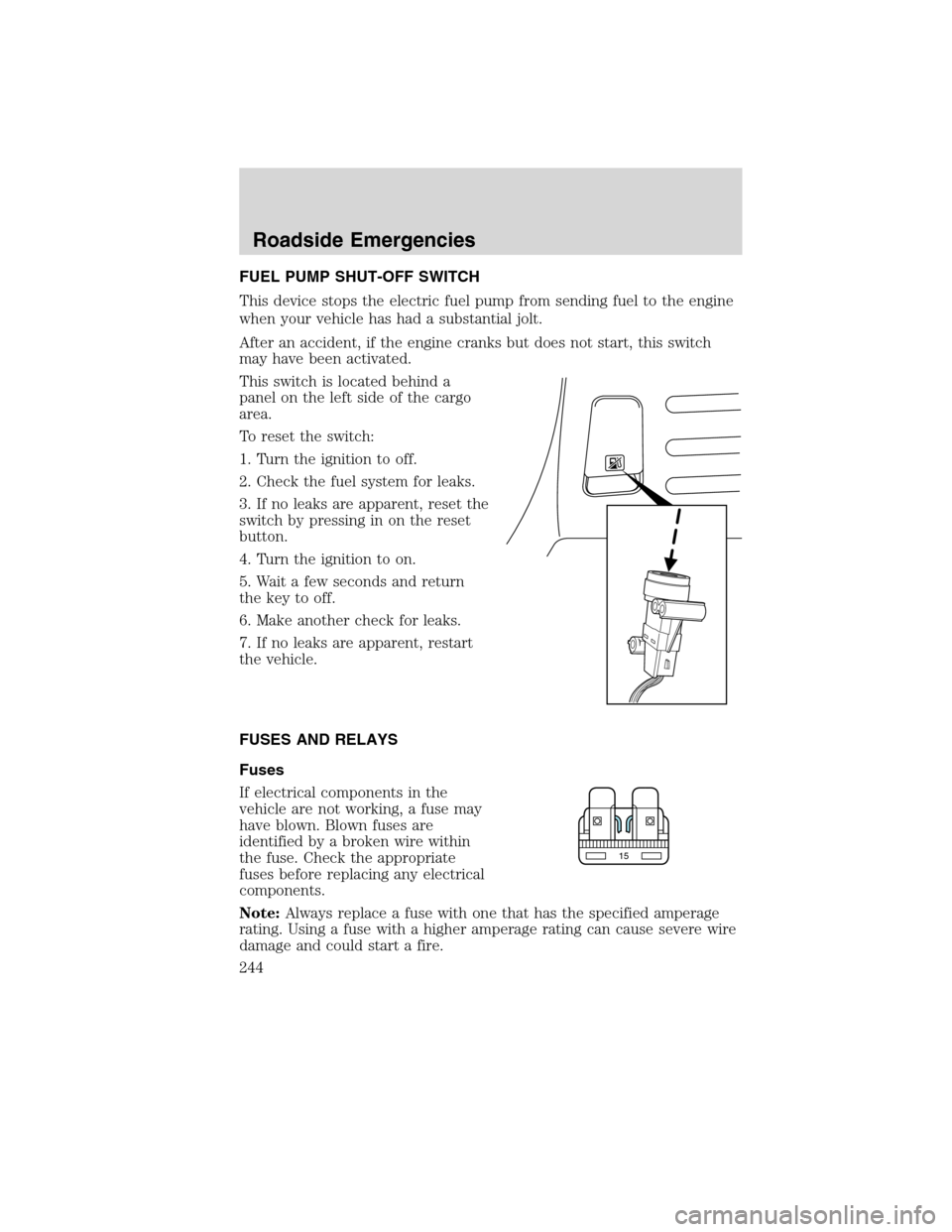
FUEL PUMP SHUT-OFF SWITCH
This device stops the electric fuel pump from sending fuel to the engine
when your vehicle has had a substantial jolt.
After an accident, if the engine cranks but does not start, this switch
may have been activated.
This switch is located behind a
panel on the left side of the cargo
area.
To reset the switch:
1. Turn the ignition to off.
2. Check the fuel system for leaks.
3. If no leaks are apparent, reset the
switch by pressing in on the reset
button.
4. Turn the ignition to on.
5. Wait a few seconds and return
the key to off.
6. Make another check for leaks.
7. If no leaks are apparent, restart
the vehicle.
FUSES AND RELAYS
Fuses
If electrical components in the
vehicle are not working, a fuse may
have blown. Blown fuses are
identified by a broken wire within
the fuse. Check the appropriate
fuses before replacing any electrical
components.
Note:Always replace a fuse with one that has the specified amperage
rating. Using a fuse with a higher amperage rating can cause severe wire
damage and could start a fire.
15
Roadside Emergencies
244
2010 Edge(edg)
Owners Guide(own2002), 1st Printing
USA(fus)
Page 250 of 328
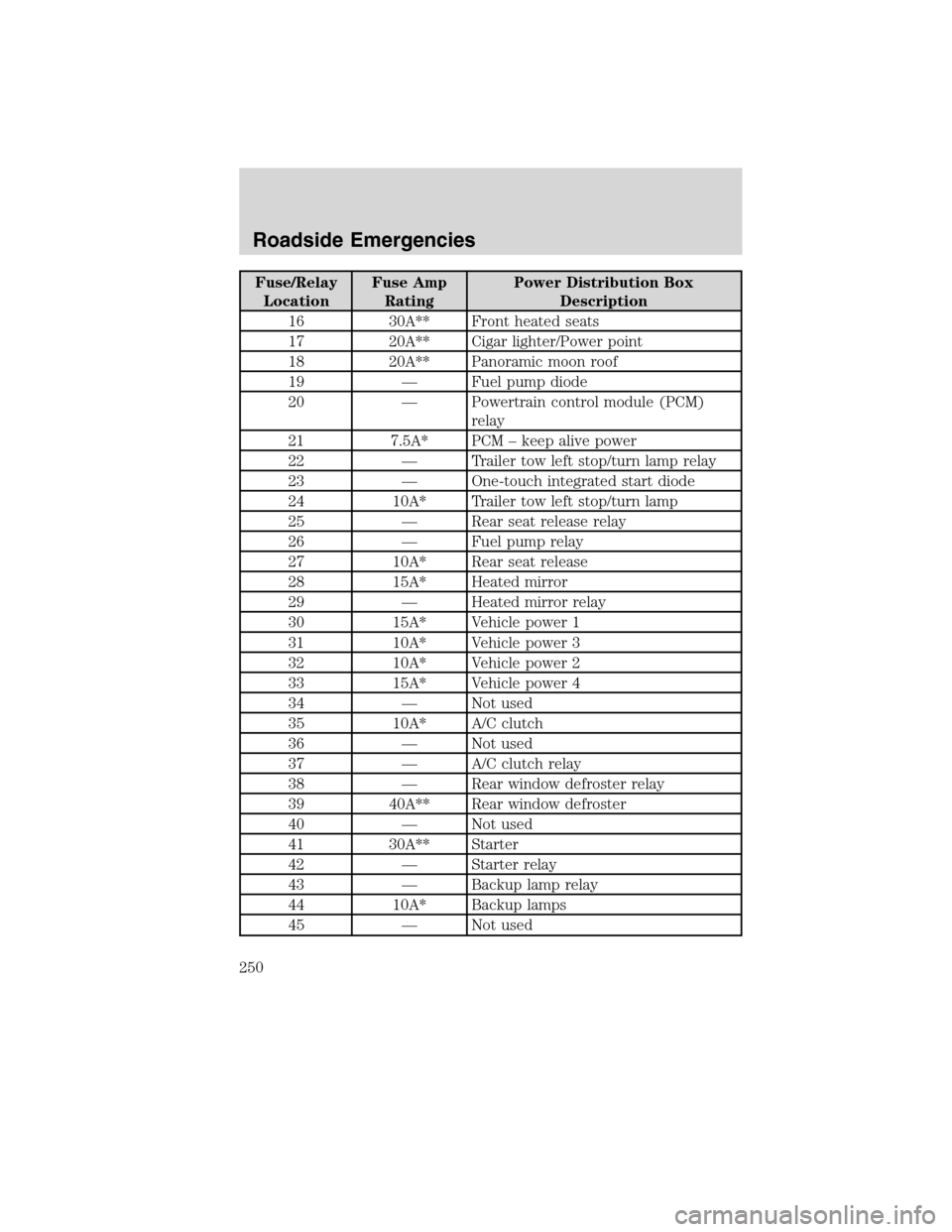
Fuse/Relay
LocationFuse Amp
RatingPower Distribution Box
Description
16 30A** Front heated seats
17 20A** Cigar lighter/Power point
18 20A** Panoramic moon roof
19 — Fuel pump diode
20 — Powertrain control module (PCM)
relay
21 7.5A* PCM – keep alive power
22 — Trailer tow left stop/turn lamp relay
23 — One-touch integrated start diode
24 10A* Trailer tow left stop/turn lamp
25 — Rear seat release relay
26 — Fuel pump relay
27 10A* Rear seat release
28 15A* Heated mirror
29 — Heated mirror relay
30 15A* Vehicle power 1
31 10A* Vehicle power 3
32 10A* Vehicle power 2
33 15A* Vehicle power 4
34 — Not used
35 10A* A/C clutch
36 — Not used
37 — A/C clutch relay
38 — Rear window defroster relay
39 40A** Rear window defroster
40 — Not used
41 30A** Starter
42 — Starter relay
43 — Backup lamp relay
44 10A* Backup lamps
45 — Not used
Roadside Emergencies
250
2010 Edge(edg)
Owners Guide(own2002), 1st Printing
USA(fus)
Page 251 of 328
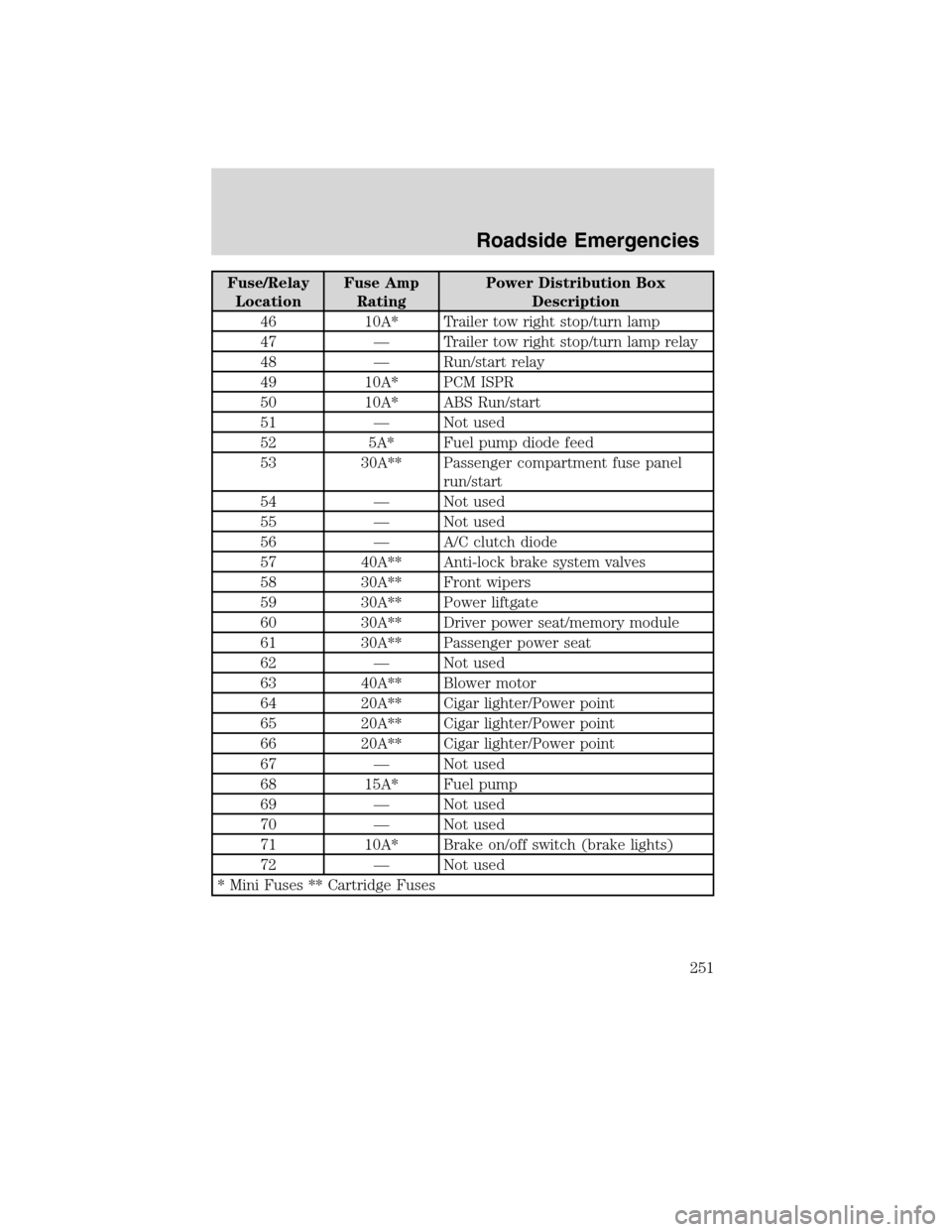
Fuse/Relay
LocationFuse Amp
RatingPower Distribution Box
Description
46 10A* Trailer tow right stop/turn lamp
47 — Trailer tow right stop/turn lamp relay
48 — Run/start relay
49 10A* PCM ISPR
50 10A* ABS Run/start
51 — Not used
52 5A* Fuel pump diode feed
53 30A** Passenger compartment fuse panel
run/start
54 — Not used
55 — Not used
56 — A/C clutch diode
57 40A** Anti-lock brake system valves
58 30A** Front wipers
59 30A** Power liftgate
60 30A** Driver power seat/memory module
61 30A** Passenger power seat
62 — Not used
63 40A** Blower motor
64 20A** Cigar lighter/Power point
65 20A** Cigar lighter/Power point
66 20A** Cigar lighter/Power point
67 — Not used
68 15A* Fuel pump
69 — Not used
70 — Not used
71 10A* Brake on/off switch (brake lights)
72 — Not used
* Mini Fuses ** Cartridge Fuses
Roadside Emergencies
251
2010 Edge(edg)
Owners Guide(own2002), 1st Printing
USA(fus)
Page 289 of 328
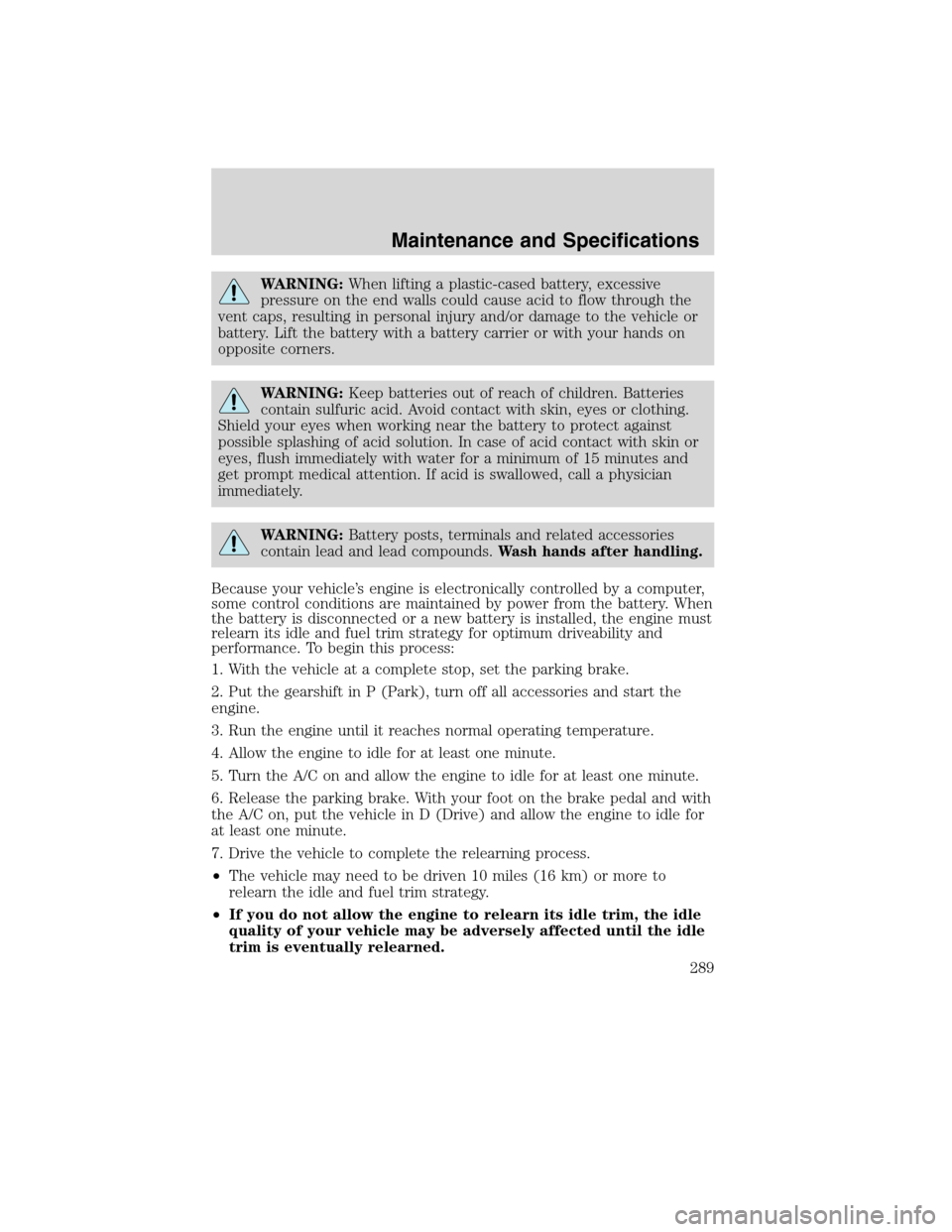
WARNING:When lifting a plastic-cased battery, excessive
pressure on the end walls could cause acid to flow through the
vent caps, resulting in personal injury and/or damage to the vehicle or
battery. Lift the battery with a battery carrier or with your hands on
opposite corners.
WARNING:Keep batteries out of reach of children. Batteries
contain sulfuric acid. Avoid contact with skin, eyes or clothing.
Shield your eyes when working near the battery to protect against
possible splashing of acid solution. In case of acid contact with skin or
eyes, flush immediately with water for a minimum of 15 minutes and
get prompt medical attention. If acid is swallowed, call a physician
immediately.
WARNING:Battery posts, terminals and related accessories
contain lead and lead compounds.Wash hands after handling.
Because your vehicle’s engine is electronically controlled by a computer,
some control conditions are maintained by power from the battery. When
the battery is disconnected or a new battery is installed, the engine must
relearn its idle and fuel trim strategy for optimum driveability and
performance. To begin this process:
1. With the vehicle at a complete stop, set the parking brake.
2. Put the gearshift in P (Park), turn off all accessories and start the
engine.
3. Run the engine until it reaches normal operating temperature.
4. Allow the engine to idle for at least one minute.
5. Turn the A/C on and allow the engine to idle for at least one minute.
6. Release the parking brake. With your foot on the brake pedal and with
the A/C on, put the vehicle in D (Drive) and allow the engine to idle for
at least one minute.
7. Drive the vehicle to complete the relearning process.
•The vehicle may need to be driven 10 miles (16 km) or more to
relearn the idle and fuel trim strategy.
•If you do not allow the engine to relearn its idle trim, the idle
quality of your vehicle may be adversely affected until the idle
trim is eventually relearned.
Maintenance and Specifications
289
2010 Edge(edg)
Owners Guide(own2002), 1st Printing
USA(fus)
Page 298 of 328
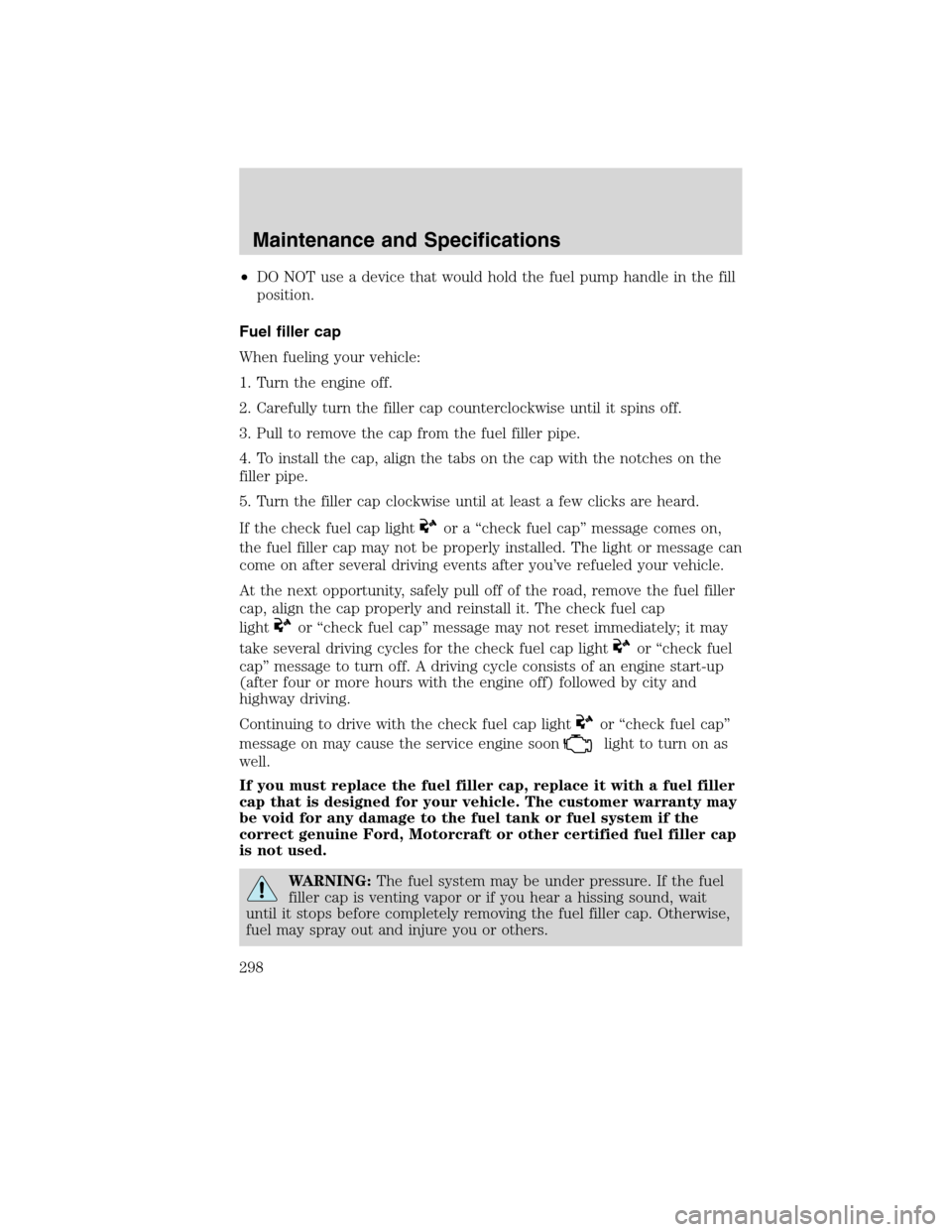
•DO NOT use a device that would hold the fuel pump handle in the fill
position.
Fuel filler cap
When fueling your vehicle:
1. Turn the engine off.
2. Carefully turn the filler cap counterclockwise until it spins off.
3. Pull to remove the cap from the fuel filler pipe.
4. To install the cap, align the tabs on the cap with the notches on the
filler pipe.
5. Turn the filler cap clockwise until at least a few clicks are heard.
If the check fuel cap light
or a “check fuel cap” message comes on,
the fuel filler cap may not be properly installed. The light or message can
come on after several driving events after you’ve refueled your vehicle.
At the next opportunity, safely pull off of the road, remove the fuel filler
cap, align the cap properly and reinstall it. The check fuel cap
light
or “check fuel cap” message may not reset immediately; it may
take several driving cycles for the check fuel cap light
or “check fuel
cap” message to turn off. A driving cycle consists of an engine start-up
(after four or more hours with the engine off) followed by city and
highway driving.
Continuing to drive with the check fuel cap light
or “check fuel cap”
message on may cause the service engine soon
light to turn on as
well.
If you must replace the fuel filler cap, replace it with a fuel filler
cap that is designed for your vehicle. The customer warranty may
be void for any damage to the fuel tank or fuel system if the
correct genuine Ford, Motorcraft or other certified fuel filler cap
is not used.
WARNING:The fuel system may be under pressure. If the fuel
filler cap is venting vapor or if you hear a hissing sound, wait
until it stops before completely removing the fuel filler cap. Otherwise,
fuel may spray out and injure you or others.
Maintenance and Specifications
298
2010 Edge(edg)
Owners Guide(own2002), 1st Printing
USA(fus)
Page 306 of 328
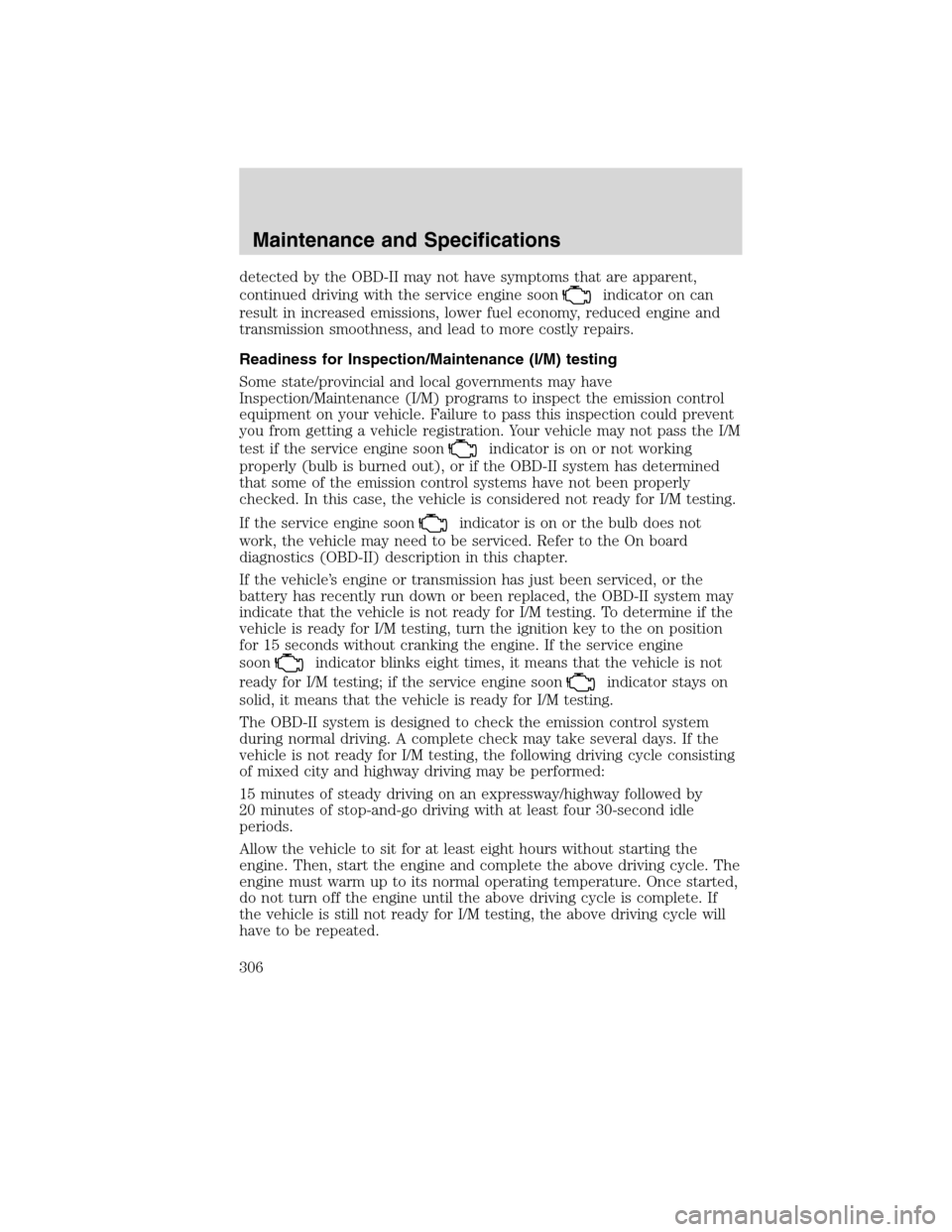
detected by the OBD-II may not have symptoms that are apparent,
continued driving with the service engine soon
indicator on can
result in increased emissions, lower fuel economy, reduced engine and
transmission smoothness, and lead to more costly repairs.
Readiness for Inspection/Maintenance (I/M) testing
Some state/provincial and local governments may have
Inspection/Maintenance (I/M) programs to inspect the emission control
equipment on your vehicle. Failure to pass this inspection could prevent
you from getting a vehicle registration. Your vehicle may not pass the I/M
test if the service engine soon
indicator is on or not working
properly (bulb is burned out), or if the OBD-II system has determined
that some of the emission control systems have not been properly
checked. In this case, the vehicle is considered not ready for I/M testing.
If the service engine soon
indicator is on or the bulb does not
work, the vehicle may need to be serviced. Refer to the On board
diagnostics (OBD-II) description in this chapter.
If the vehicle’s engine or transmission has just been serviced, or the
battery has recently run down or been replaced, the OBD-II system may
indicate that the vehicle is not ready for I/M testing. To determine if the
vehicle is ready for I/M testing, turn the ignition key to the on position
for 15 seconds without cranking the engine. If the service engine
soon
indicator blinks eight times, it means that the vehicle is not
ready for I/M testing; if the service engine soon
indicator stays on
solid, it means that the vehicle is ready for I/M testing.
The OBD-II system is designed to check the emission control system
during normal driving. A complete check may take several days. If the
vehicle is not ready for I/M testing, the following driving cycle consisting
of mixed city and highway driving may be performed:
15 minutes of steady driving on an expressway/highway followed by
20 minutes of stop-and-go driving with at least four 30-second idle
periods.
Allow the vehicle to sit for at least eight hours without starting the
engine. Then, start the engine and complete the above driving cycle. The
engine must warm up to its normal operating temperature. Once started,
do not turn off the engine until the above driving cycle is complete. If
the vehicle is still not ready for I/M testing, the above driving cycle will
have to be repeated.
Maintenance and Specifications
306
2010 Edge(edg)
Owners Guide(own2002), 1st Printing
USA(fus)